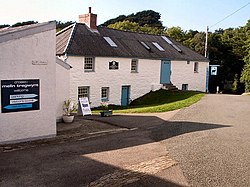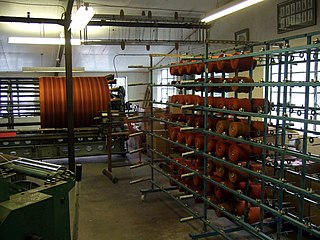Tregwynt Mill
| Tregwynt Mill Welsh: Melin Tregwynt | |
|
Pembrokeshire | |
|---|---|
 Tregwynt Woollen Mill | |
| Type: | Watermill |
| Location | |
| Grid reference: | SM89403484 |
| Location: | 51°58’19"N, 5°4’3"W |
| Village: | Tregwynt |
| History | |
| Built 1819 | |
| Watermill | |
| Information | |
| Website: | melintregwynt.co.uk |
Tregwynt Mill is a commercially operational woollen mill in the hamlet of Tregwynt in the parish of Granston, near the north coast of Pembrokeshire. It is a Grade II listed building.[1]
A mill has stood on this site since 1819 taking fleeces from the sheep farms of the area, carding and spinning them into woollen yarn and then weaving the yarn into cloth and blankets.
The mill is operating to this day – now making a line of upmarket blankets, cushions, clothing and accessories, and trading more usually under its Welsh name Melin Tregwynt.
History
Tregwynt Mill stands in an isolated Pembrokeshire valley, running down to the sea. The Pembrokeshire Coast Path runs just three-quarters of a mile from the mill.
The building long was part of the Tregwynt estate.[2] It was originally a corn mill, and was converted to a woollen mill later in the 19th century.[3]
On 1841 Tithe Map it was called Dyffryn Bach, owned by G. J. Harries and occupied by David Evans.[1]
The local farmers would sell their fleeces to the mill, which would wash, card, comb and spin the wool into yarn and then weave it into blankets.[4]
The present owner's grandfather bought the mill for £760 in May 1912 and operated it with his son. During the Second World War the mill devoted most of its capacity to making knitting wool, which was not rationed.[4] Then in the 1950s the owners opened a shop at the mill for tourists, opened shops in St Davids and Fishguard, and started to develop Melin Tregwynt as a brand.[4]
The business continued to thrive in the 1960s and 1970s and survived the recession in the 1980s that forced many Welsh mills to close. When the founder's grandson entered the business, he started to develop foreign markets.
Construction
The building is of hipped and whitewashed rubble stone, and has the date of 'July 1819' on a roof truss.[1]
The mill was powered by water from the local stream,[2], but in an unusual design feature, the water wheel is inside the building. [3]
The water wheel is a large, iron overshot wheel which probably dates to the later part of the 19th century.[1] The water wheel drove hammers that beat the woven cloth to clean and soften it.[2] Later the wheel drove leather belts that powered the carding engines and looms.
This equipment has been preserved in the old section of the mill.[2]
Recent years
As of 1997 the mill was weaving two miles of cloth each month.[5]
Melin Tregwynt now outsources some processes, including carding and spinning.[4] The mill's water wheel still functions, but is no longer used to power the machinery.[6]
The 2008 Guinness Book of Records noted that the mill had woven the world's largest picnic blanket, for Waitrose. In 2012 the mill celebrated 100 years as a family business, now weaving for a global market.[4]
The mill today makes fashionable blankets, cushions, bags and other finished products.[4] The looms are still manually warped, the knots are tied by hand and the blankets are finished by hand.[7]
Melin Tregwynt also now operates a café at the mill and a shop that sells clothing, bags, lampshades and ceramics.
In the media
In September 2012 Melin Tregwynt products were featured at Heal's in London during the London Design Festival.[4] In that year the fashion designer Jayne Pierson created a line of bespoke women's wear for Melin Tregwynt.
The mill featured in a BBC Two Wales Made in Wales episode in December 2012.[8]
As of 2016 the mill employed about 30 people.[9]
Pictures
-
Gear shaft
-
Loom
-
Water wheel
-
Racks of wool
Outside links
| ("Wikimedia Commons" has material about Tregwynt Mill) |
References
- ↑ 1.0 1.1 1.2 1.3 Tregwynt Woollen Mill – Historic Wales
- ↑ 2.0 2.1 2.2 2.3 Nelson, Daniel: '100 Years of Melin Tregwynt: ateliertally.com, 11 April 2013
- ↑ 3.0 3.1 Lloyd, Thomas; Orbach, Julian, Scourfield, Robert: 'Pembrokeshire' (Yale University Press, 2004) ISBN 978-0-300-10178-2
- ↑ 4.0 4.1 4.2 4.3 4.4 4.5 4.6 '100 years of Welsh weavers Melin Tregwynt': Kirstie McCrum on Wales online, 22 September 2012
- ↑ Country Life, 1997
- ↑ Melin Tregwynt – Welsh Mills Society
- ↑ 'A visit to Melin Tregwynt, Welsh blanket makers': Sheepskin Life
- ↑ Made in Wales: Melin Tregwynt – BBC
- ↑ A little about us… Melin Tregwynt




